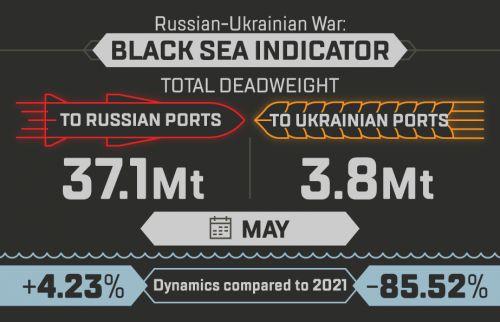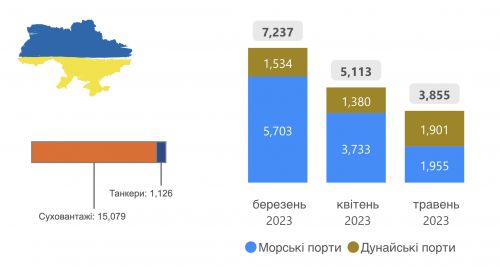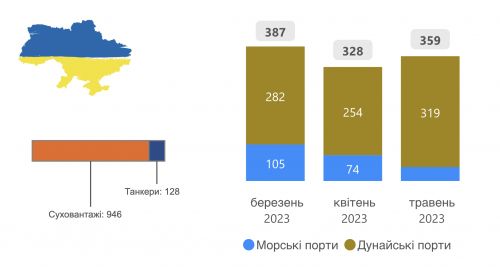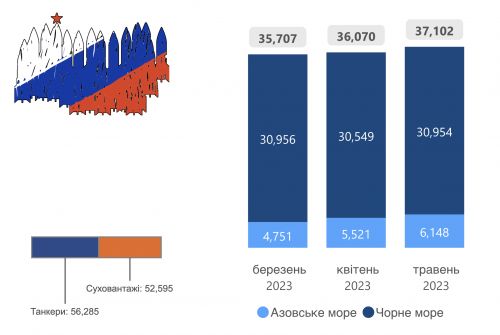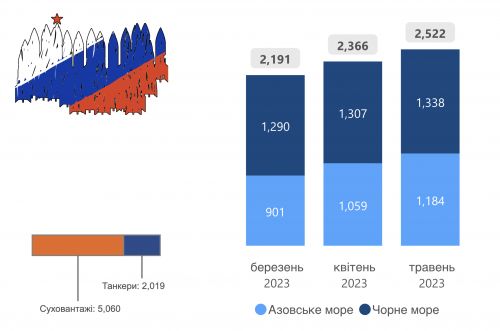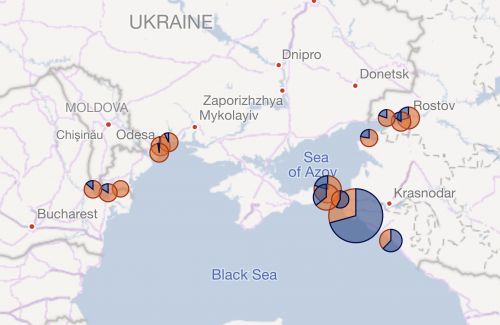Opportunities to export Ukrainian goods are limited because of the blocking of freedom of navigation in the Black Sea by Russia, the occupation of Ukraine’s ports on the Sea of Azov, and numerous obstacles to the operation of the Black Sea "grain corridor." Meanwhile, Russian seaports on the Black Sea and the Sea of Azov are receiving vessels without restrictions, sometimes increasing cargo transshipment volumes and generating budget revenues for Russia.
The Black Sea Indicator project by the CFTS and Maritime Logistics monitors the total deadweight tonnage and the number of vessels processed by seaports in Ukraine and the Black Sea/Sea of Azov region of Russia. A comparison of the latest indicators and the pre-war 2021 indicators is also provided to help understand the unfair disparity caused by the blockade of Ukrainian ports.
Dynamics of freight transshipment in Ukrainian and Russian ports in May 2023
The total deadweight tonnage of the ships that entered the Ukrainian Black Sea ports that are partially in operation and those that entered Ukraine’s ports on the River Danube was 3.8 million tons in May 2023. This is 85.5% lower than the average monthly figure for Ukrainian seaports in 2021 and 81% lower than the figure for April 2023 (5.1 million tons).
The difference is even starker when compared with the Russian ports on the Sea of Azov and the Black Sea. While the total deadweight tonnage of the ships that entered the Russian seaports was seven times higher than the deadweight tonnage of the ships that entered Ukrainian ports in April, it was almost 10 times higher in May. Russian ports in the region received vessels with a deadweight tonnage of 37.1 million tons in April, a 4% increase compared with the average monthly deadweight tonnage in 2021. In addition, Russian seaports in the Sea of Azov and the Black Sea surpassed the figure for April, when they received ships with a total deadweight tonnage of 35.9 million tons.
These figures show only one thing: Russia continues to lead the parties to the negotiation process around the Black Sea Grain Initiative "up the garden path" by unlawfully restricting the passage of ships to Ukrainian ports and constantly increasing the ship traffic to its own ports with no international inspection of the ships’ cargo. This is to say nothing of the broader aspect of the problem, which is that Russia has essentially monopolized shipping in the Black Sea by threatening force against commercial vessels. This amounts to common piracy, to which the international community is turning a blind eye.
The most striking confirmation of these is that only 40 ships called at the ports of Greater Odesa in May! This is almost half the number of ships that called at these ports in April (at least 74). Meanwhile, Russia’s Black Sea ports received 1,059 and 1,184 vessels in April and May, respectively.
What is the reason for this disparity? We remember that the first half of May was marked by efforts to persuade Russia to unblock and extend the Black Sea Grain Initiative. Nevertheless, Russia’s representatives at the Black Sea Grain Initiative’s Joint Coordination Center in Istanbul sabotaged inspections of ships heading to Ukrainian ports as much as possible. As a result, an average of two vessels sailed to the ports of Greater Odesa per day in the first week of April, after which the number of vessels that sailed to these ports dropped to zero for almost two weeks and rose to an average of three per day at the end of the month. However, Russia’s representatives stopped allowing ships to enter the Pivdennyi seaport, Ukraine's largest seaport.
Commenting on this situation, some experts believe (but the authorities do not yet dare to say) that it is time to ignore Russia the same way Russia is ignoring the needs of others. After all, the ship traffic to Russian ports may suddenly find itself under no less of a hypothetical war-related threat than the ship traffic to Ukrainian ports. Given that this ship traffic consists largely of oil tankers (as we will show later in this analysis), Russia's financial losses could turn out to be no less.
As American diplomat Kurt Volker noted, "It would be incredibly brazen and ill-considered of Russia to attack international shipping in the open waters of the Black Sea. It is time to call Russia’s bluff and open the port of Odesa (read Ukrainian ports) for good."
Meanwhile, we have the following situation...
Distribution of total deadweight tonnage of ships entering Ukrainian ports
As for the Ukrainian ports that are currently operating in one format or another, the deadweight tonnage of the vessels they processed by the ports on the Black Sea and River Danube was almost the same in May, perhaps for the first time. Danube ports processed vessels with a total deadweight tonnage of 1.9 million tons and the ports of Greater Odesa processed ships with a total deadweight tonnage of 1.95 million tons. On the one hand, this is because of the success of the Izmail and Reni ports and the result of the operational dredging of the Ukrainian section of the Danube River’s Bystre estuary. On the other hand, it is the consequence of the Russian sabotage of Ukraine’s "high-water" ports.
Ukrainian ports received tankers with a total deadweight tonnage of 1.13 million tons and dry-cargo vessels with a total deadweight tonnage of 15.1 million tons in the first five months of 2023.
Breakdown of total deadweight tonnage (thousand tons) of ships entering Ukrainian ports by ship type and port category
Distribution of number of ship calls at Ukrainian ports
The number of ship calls at all the Ukrainian ports that are open or partially open totaled 359 in May, up from 328 in April. This figure was reached because of the country’s Danube ports, which process small vessels. In contrast to the above-mentioned 40 vessels that the Odesa ports received in May, Ukraine’s Danube ports processed 271 vessels (compared with 226 vessels in April).
Over the three months of spring, 946 dry cargo vessels and 128 tankers called at Ukrainian ports.
Breakdown of number of ship calls at Ukrainian ports by ship type and port category
Distribution of total deadweight tonnage of vessels calling at Russian ports
Against the backdrop of the fall in the number of ship calls at Ukrainian ports, Russian ports on the Black Sea and the Sea of Azov are increasing their transshipment volumes despite the Russian authorities constantly engaging in manipulations and claiming that Russian shippers are incurring losses.
For example, the Russian ports on the Sea of Azov handled ships with a total deadweight tonnage of 6.15 million tons in May (compared with 5.5 million tons in April), which is almost twice the combined deadweight tonnage of the ships handled by all Ukrainian ports. Russian ports on the Black Sea received vessels with a total deadweight tonnage of 30.9 million tons, which is more than the combined deadweight tonnage of the ships handled by all Ukrainian ports since the beginning of this year. Russian ports in the Black Sea/Sea of Azov region received ships with a total deadweight tonnage of 37.1 million tons in May.
In the past three months, Russian ports have handled dry cargo vessels with a total deadweight tonnage of 52.6 million and tankers with a total deadweight tonnage of 56.3 million. That is "not bad," considering the existence of an oil embargo. On the other hand, this is exactly what was mentioned above: Russia should be forced to think about the safety of oil ships in the Black Sea no less than Ukraine thinks about the safety of grain bulk carriers...
Breakdown of total deadweight tonnage (thousand tons) of ships entering Russian ports by ship type and port category
Distribution of number of ship calls at Russian ports
While deadweight tonnage was split roughly equally between dry cargo vessels and tankers during March-May, the number of tankers was less than half (2,019 tankers compared with 5,060 dry cargo vessels).
The number of ship calls at Russia's ports on the Sea of Azov was 1,184 in May, almost four times more than the combined number of ship calls at all the Ukrainian ports in operation. The number of ship calls at Russia’s ports on the Black Sea was 1,338. Russia’s ports in the Black Sea/Sea of Azov region received 2,522 vessels in May, according to the available data.
Breakdown of ship calls at Russian ports by vessel type and port category
Distribution of total deadweight tonnage of ships entering ports
Among Ukrainian ports, the Odesa seaport processed ships with the largest deadweight tonnage (4 million tons) in March-May, followed by the Pivdennyi seaport (3.8 million tons), and the Chornomorsk seaport (3.5 million tons). Among Ukraine’s Danube ports, the Izmail port processed ships with the largest deadweight tonnage (2.7 million tons).
The Novorossiysk seaport is the leader in the region among Russian seaports. This seaport received ships with a total deadweight tonnage of 53.9 million tons in the three months of spring 2023. The port of Kavkaz received ships with a total deadweight tonnage of 15.7 million tons and the port of Taman received ships with a total deadweight tonnage of 13.9 million tons. On the Sea of Azov, the Port of Rostov-on-Don received ships with the largest total deadweight tonnage (8.2 million tons).
Distribution of total deadweight tonnage of ships entering ports
Distribution of the number of ship calls at ports
In terms of the number of ship calls at ports in March-May, the Izmail seaport was the leader among Ukrainian ports with 467, followed by the Reni port with 305.
Among the ports of Greater Odesa, the Odesa seaport received the largest number of ships in March-May (80).
Among Russian ports, the port of Kavkaz was the leader in terms of number of ship calls (1,765), followed by the Port of Rostov-on-Don (1,573) and the Novorossiysk seaport (1,500).
Distribution of number of ship calls at ports

